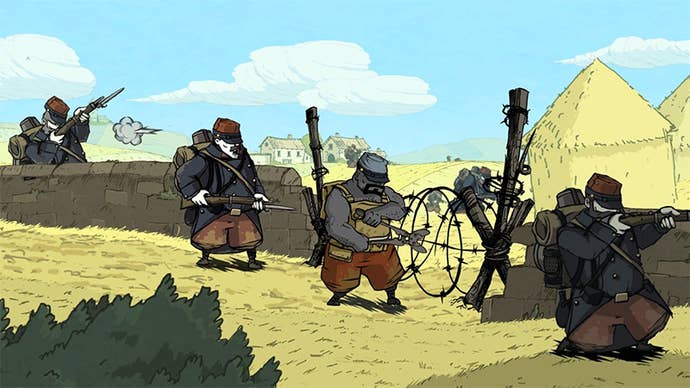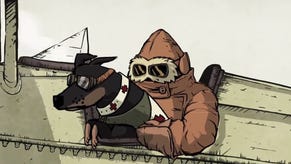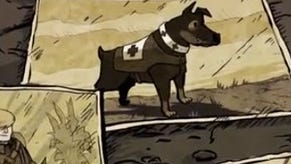Valiant Hearts: The Great War PC Review: All Quiet on the Western Front
Ubisoft Montpellier delivers an unexpected and informative interpretation of World War I, one that unfortunately falls victim to the reputation of its publisher.
This article first appeared on USgamer, a partner publication of VG247. Some content, such as this article, has been migrated to VG247 for posterity after USgamer's closure - but it has not been edited or further vetted by the VG247 team.
I'll be the first to admit that I remained profoundly ignorant about World War I until well into my adult life. Before I took a college class that covered this drawn-out conflict, the only thing I associated with WWI were vague ideas about trenches, hats with pointy spikes on them, and some guy named "The Kaiser—" possibly related to the dinner rolls of the same name. With its enigmatic villains, clear-cut conflicts, and voluntary enlistment from some of our country's most famous cartoon characters, it's easy to see why The Great War's sequel dominates so much more of our attention.
And that's the reason Ubisoft made this game—the World War I setting of Valiant Hearts doesn't exist for the sake of novelty alone. It's both a memorial and a teaching tool, executed through what most would call the mechanics of a classic adventure game. By following the lives of four very different characters, Valiant Hearts attempts to sum up a very complicated war through personal (albeit fabricated) stories, historical footnotes, and a dash of creative license. The result is an urgent and, at times, moving experience that effortlessly bounces between many varieties of game play on a whim, yet still manages to drag on without an end in sight—much like the war that inspired it.

Valiant Hearts' best quality can be found in how many different scenarios it puts its characters through, and how the game communicates so much information with images alone. While we hear these characters narrate events between playable sections, the only speech heard in the game itself comes in the form of Simlish-style muttered approximations of the language in question—plus a few intelligible words and phrases you probably picked up in high school. This abstraction helps keeps Valiant Hearts moving at a steady pace, something the game does extremely well. These vignettes rarely linger, and they have a habit of changing wildly from one segment to the next—often within the same scene—so you're never trapped doing the same thing with the same character for too long.
Like Ron Gilbert's The Cave and the recent Stick it to the Man!, Valiant Hearts approaches its adventure game mechanics in a very thoughtful and modernized way by limiting the items you can carry, and cutting down on the amount of things characters can interact with. And, thanks to its helpful-but-not-insulting hint system, the game is more than willing to nudge you in the right direction without spoiling everything immediately. Valiant Hearts offers your standard inventory puzzles, where you give item A to person B and so on until the chain is complete, but the game contains some clever environmental challenges as well. Ubisoft might take a few liberties with the setting—I doubt the battlefields of World War I were replete with so many levers, pulleys, and switches—but these puzzles make for some of the best parts of the game, especially when you're forced to work in tandem with another character to pass a gauntlet of deadly obstacles. Valiant Hearts also presents some pretty basic action segments that manage to be fast-paced but not all that punishing, and usually arrive to give you a jolt right after you've finished a more laid-back scene. These bits are functional and competent at best, but still, there's something to be said about weaving a truck between incoming shells timed perfectly to the strings of "In the Hall of the Mountain King."

This is an Ubisoft game, of course, and even though Valiant Hearts is one of their more experimental projects, it glows with the production values you'd expect from the publisher. Valiant Hearts' simple, 2D art style is evocative, versatile, and often beautiful, even when depicting the horrors of war. The audio is just as lush as the visuals, with some great vocal performances from narrator and gibberish-mumbler alike, excellent sound mixing, and incredibly poignant and well-deployed music. Unfortunately, Valiant Hearts carries a few of the unfortunate trends of its developer, hinted at the second you start the game and read the title screen text: "There are more than 100 collectible items in Valiant Hearts! Can you find them all?" That kinda clashes with the haunting image of a soldier and his dog standing in the middle of a desolate, war-torn battlefield.
Surprisingly, the addition of collectibles to Valiant Hearts is done effectively; they feel natural to their surroundings, and when you pick one of them up, you get information about that specific item's use in the context of World War I. But this element of the game points to a desire to make Valiant Hearts a much lengthier experience than it needs to be, which ultimately affected my enjoyment. Instead of pulling back on an idea just as you crave more, Valiant Hearts is happy to serve up buffet-style takes on experiences that would have worked best as a single serving. Though the game moves at a snappy pace, it often drops the same type of segments into your lap over and over again—if you get tired of playing the same rhythm mini-game after resuscitating your fifth fallen soldier, things aren't going to be any more interesting after your dozenth.
Ultimately, this is what transformed Valiant Hearts from a great game into a good one for me. Outside of series like Rayman, Ubisoft games always deliver an excessive amount of content, so maybe they were feeling insecure about the prospect of releasing a product that only consumed a few hours of a person's life? Whatever the case, Valiant Hearts would be worth the price of admission at half its length, but in its current state, the game rambles on far too long. It's not that I didn't want to see more of these characters—I just wanted to see them doing different things. Kudos to Ubisoft for running with such an outlandish concept, but as trite as the expression may be, I hope the developer one day realizes that less can often be so much more.
VisualsValiant Hearts' art style is confident, stunning, and versatile. It might not have the most CPU-taxing graphical effects for a game released in 2014, but Valiant Hearts uses its visuals effectively.
SoundThe game mixes authentic tunes of the era with a great original soundtrack, which provides excellent accompaniment to the action on-screen.
InterfaceValiant Hearts' visuals are free of any UI clutter, which lets the great art shine through. The menus seem to be somewhat of a rush job, though they're still completely manageable.
Lasting AppealIt's doubtful you'll want to play through Valiant Hearts more than once, though the game lets you jump to a specific scene if you're interested in revisiting some of the highlights.
ConclusionValiant Hearts works from a novel concept, and is loaded with brilliant ideas—hell, it's great just to see a war from the perspective of a country other than America—but Ubisoft's lack of self-control ultimately makes it less impactful than it should have been. It's still a worthwhile experience, though it could have been so much better if Valiant Hearts left us wanting more.














